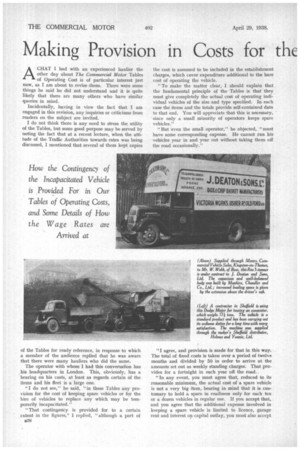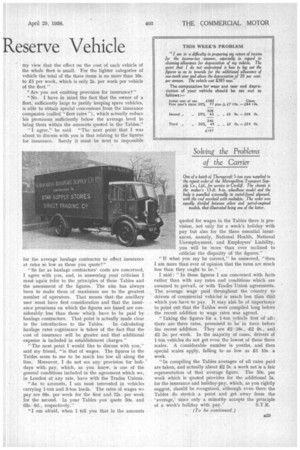Making Provision in Costs for the Reserve Vehicle
Page 48

Page 49

If you've noticed an error in this article please click here to report it so we can fix it.
ACHAT I had with an experienced haulier the other day about The Commercial Motor Tables of Operating Cost is of particular interest just now, as I am about to revise ,them. There were some things he said he did not understand and it is quite likely that there are many others who have similar queries in mind.
Incidentally, having in view the fact that I am engaged in this revision, any inquiries or criticisms from readers on the subject are invited.
I do not think there is any need to stress the utility of the Tables, but some good purpose may be served by noting the fact that at a recent lecture, when the attitude of the Traffic Authorities towards rates was being discussed, I mentioned that several of them kept copies of the Tables for ready reference, in response to which a member of the audience replied that he was aware that there were many hauliers who did the same.
The operator with whom I had this conversation has his headquarters in London. This, obviously, has a bearing on his costs, at least as regards certain of the items and his fleet is a large one.
"I do not see," he said, in these Tables any provision for the cost of keeping spare vehicles or for the hire of vehicles to replace any which, may be temporarily incapacitated."
"That contingency is provided for to a certain extent in the figures," I replied, "although a part of B3S the cost is assumed to be included in the establishment charges, which cover expenditure additional to the bare cost of operating the vehicle.
"To make the matter clear, I should explain that the fundamental principle of the Tables is that they must give completely the actual cost of operating individual vehicles of the size and type specified. In each case the items and the totals provide self-contained data to that end. You will appreciate that this is necessary, since only a small minority of operators keeps spare vehicles."
"But even the small operator," he objected, "must have some corresponding expense. He cannot run his vehicles year in and year out without taking them off the road occasionally."
"1 agree, and provision is made for that in this way. The total of fixed costs is taken over a period of twelve months and divided by 50 in order to arrive at the amounts set out as weekly standing charges. That provides for a fortnight in each year off the road..
"In any event, you must agree that, reduced to its reasonable minimum, the actual cost of a spare vehicle is not a very big item, bearing in mind that it is customary to hold a spare in readiness only for each ten or a dozen vehicles in regular use. If you accept that, and you agree that the additional expense involved in keeping a spare vehicle is limited to licence, garage rent and interest on capital outlay, you must also accept my view that the effect on the cost of each vehicle of the whole fleet is small. For the lighter categories of vehicle the total of the three items is no more than 16s. to 21 per week, which is only 2s. per week per vehicle of the fleet."
"Are you not omitting provision for insurance?"
"No. I have in mind the fact that the owner of a fleet, sufficiently large to justify keeping spare vehicles, is able to obtain special concessions from the insurance companies (called "fleet rates "), which actually reduce his premiums sufficiently below the average level to bring them within the amounts quoted in the Tables."
"I agree," he said. "The next point that I was about to discuss with you is that relating to the figures for insurance. Surely it must be next to impossible for the average haulage contractor to effect insurance at rates so low as those you quote?"
"So far as haulage contractors' costs are concerned, I agree with you, and, in answering your criticism I must again refer to the principles of these Tables and the assessment of the figures. The aim has always been to make them of maximum use to the greatest number of operators. That means that the ancillary user must have first consideration and that the insurance premiums on which the figures are based are considerably less than those which have to be paid by haulage contractors. That point is actually made clear
in the introduction to the Tables. In calculating haulage rates cognizance is taken of the fact that the cost of insurance will be greater and that additional expense is included in establishment charges."
"The next point I would like to discuss with you," said my friend, "is that of wages. The figures in the Tables seem to me to be much too low all along the line. Moreover, I do not see any provision for holidays withpay, which, as you know, is one of the general conditions included in the agreement which we, in London at any rate, have with the Trades Unions.
"As to amounts, I am most interested in vehicles carrying 1-ton and 3-ton loads. The rates of wages we pay are 66s, per week for the first and 72s. per week for the second. In your Tables you quote 50s. and 03s. 6d,, respectively.'.'
"I am afraid, when I tell you that in the amounts
quoted for wages in the Tables there is provision, not only for a week's holiday with pay but also for the three essential insurances, namely, National Health, National Unemployment, and Employers' Liability, you will be more than ever inclined to criticize the disparity of the figures."
"If what you say be correct," he answered, "then I am more than ever of opinion that the rates are much less than they ought to be."
I said: "In these figures I am concerned with facts rather than with any rates and conditions which are assumed to prevail, or with Trades Union agreements. The average wage paid throughout the country to drivers of commercial vehicles is much less than that which you have to pay. It may also be of importance to point out that the Tables were compiled long before the recent addition to wage rates was agreed.
." Taking the figures for a 1-ton vehicle first of all: there are three rates, presumed to be in force before the recent addition. They are 22 18s., -a2 9s., and £2 5s. per week. In the majority of cases, drivers of 1-ton vehicles do not get even the lowest of those three scales. A considerable number is youths, and then special scales apply, falling to as low as £1 10s. a week.
"In compiling the Tables averages of all rates paid are taken, and actually about £2 5s. a week net is a fair representation of that average figure. The 50s. per week which is quoted provides for the additional 5s, for the insurance and holiday-pay, which, as you rightly suggest, should be recognized, although even there the Tables do stretch a point and get away from the average,' since only a minority accepts the principle
of a week's holiday with pay." S.T.R.






















































































